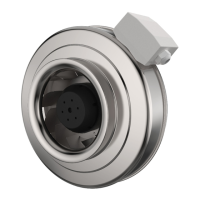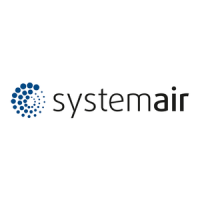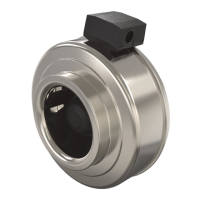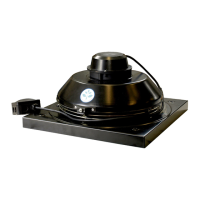202
341 (10-03-2011)
Original
6
GB IE
Safety Information
This machinery must not be put into operation until prior to
reading mounting instructions and safety information.
All fans are intended for transportation of air in air handling
systems. If installed in non-heated rooms, the fan casing
has to be insulated in order to avoid condensation. They are
meant to be used after building them into machines or duct
systems or after contact protection grid has been installed.
(EN ISO 13857). Fans with duct connections must be
connected to ducts on both sides (inlet/outlet). When there
is a risk of water entering the motor, via the ducts, external
protection is required. No moving parts shall be accessible
after installation. The fans are not to be used in hazardous
environments or connected to flue ducts. The fans must not
be installed outdoors, (with exception of roof fans and fans
with, for this purpose, corresponding IP class). If the fans
are installed without insulation in non-heated areas there is
a risk of condensation. Safety accessories (i.e. motor
protection, safety grille) may not be dismounted, short cut or
disconnected. CAUTION Before servicing or maintenance,
switch off power, (all-pole circuit breaker), and make sure
the impeller has come a standstill. CAUTION The fans can
have sharp edges and corners which may cause injuries.
CAUTION Be careful when opening the fans service-
hatches (swing-out), the fan and motor assembled on the
hatch is relatively heavy.
Transportation and Storage
All fans are packaged at the factory to withstand normal
transport handling. When handling the goods use suitable
lifting equipment in order to avoid damage to fans and
personnel. Do not lift the fans by the connecting cable,
connection box, impeller or inlet cone. Avoid blows and
shock loads. Store the fans in a dry place protected from
weather and dirt until final installation.
Installation
Refer to Safety information above. Installation, electrical
connection and commissioning are only to be carried out by
authorised personnel and in accordance with requirements
and demands. Electrical connections are made according to
the wiring diagram in the terminal box, markings on terminal
blocks or on cable. All 3 phase fans are delivered from
factory in 400V 3~ connection. CAUTION Do not use metal
compression gland fittings with plastic terminal boxes. Use
a dummy plug seal for the compression gland fitting as well.
The K-fan must be installed with the connection box at the
top of the unit ± 90 degrees. The K fan If permanent
installation is carried out using cables with diameter 12-14
mm, the entrance bushing must be replaced (applies to type
K, KV, RVF and KVK 125/160). To preserve IP44 the RS
fans must not be mounted with the connection box/motor
plate upwards (fig.1). Fans with thermal contacts with
external leads (TK) must always be connected to external
motor protection. Assemble the fan in the direction of airflow
(see arrow on unit). The fan must be installed so that
vibrations are not transmitted to duct systems or frame of
building. (Suitable accessories like fast clamps and
diffusers are available). Make sure the assembly of the fan
is firmly fixed and stable. The fan can be mounted in any
direction unless stated otherwise. The fans must be
assembled so that service and maintenance can be
performed easily and safely. Disturbing noise can be
avoided by installing silencer (available accessory).
For frequency regulation an all pole sinus filter must be
mounted between motor and frequency controller (version
all poles: phase to phase, phase to earth). Fans are meant
for continuous use within the temperature range stated.
Fans with manual thermal contacts (reset by cutting the
current, motor protection SP1), must be taken into
consideration when connecting surrounding equipment with
automatic on/off function.
Operation
Before initial operation, check the following:
- Electrical connection has been properly completed.
- Protective conductor has been connected.
- Motor protection installed.
- Safety devices in place (protection grid)
- Leftover installation materials and foreign materials have
been removed from the casing.
When putting into operation, check thefollowing:
- Connection data corresponds to the specifications on the
nameplate: Maximum voltage +6%, -10%, according to IEC
38. Rated current must not be exceeded with more than 5%
at rated voltage. CAUTION When speed regulating by
reducing the voltage the motor current may exceed the
rated current at a lower voltage. In this case the motor
windings are protected by the thermal contact. The
minimum static fall of pressure must observed.
- That the motor protection is functional. The direction of
rotation should correspond to direction-of-rotation arrow (3
phase).
- Smoothness of motor operation, (no abnormal noises).
-Fans must only be operated by a person that has
sustainable knowledge or education within this field or
handling must be carried out with the supervision of such
person.
Sound levels exceeding 70 dB(A) may occur depending on
model and size (see online catalogue at
www.systemair.com for detailed information)
Maintenance, Service and Repair
Before maintenance, service or repair make sure that:
- Power supply is interrupted (all-pole circuit breaker).
- Fan impeller has come to a complete standstill
- Observe personnel safety regulations!
The fan should be cleaned when necessary, at least 1/year
to avoid imbalance and unnecessary damage to the
bearings. A filter will prolong the time interval between each
cleaning of the fan. (It is sometimes recommended to install
a filter guard). The fan bearings are maintenance free and
should only be replaced if damaged. Do not use a high-
pressure cleaner (steam jet) when cleaning the fan. Make
sure the fan impeller's balance weights are not moved or
the fan impeller distorted. Listen for abnormal operating
noise.
Resetting of the thermal trips
Manual thermal trips (SP1) are reset by disconnecting the
mains for approx. 10-20min.
Fans with external leads for thermal trips (TK) are reset
from the external motor protection. This protection may not
have automatic resetting.
Make sure the fan has not been blocked or that the motor
protection has tripped. Contact the supplier if the motor
does not start after controlling and/or resetting the motor
protection.
